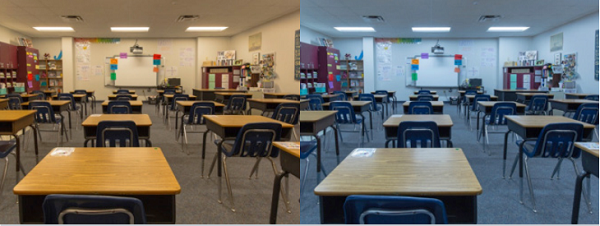The U.S. Department of Energy's GATEWAY program has released a new report on a trial installation of tunable-white LED lighting systems in three classrooms in the Carrollton-Farmers Branch Independent School District in Carrollton, TX, which provides valuable insights into the use of this technology in a real-world setting.
The LED systems were installed in August 2016 and provide the ability to vary the spectral power distribution (SPD) across four preset conditions associated with nominal CCTs of 3000 K, 3500 K, 4200 K, and 5000 K. The controls also provide for preset scenes to vary the on/off status and dimming level of different luminaire zones within the room, to better support such classroom functions as audiovisual presentations.
 |
|
(Image: The US Department of Energy) |
Among the key takeaways:
-
The reduction in input power for the tunable-white LED lighting system was estimated to be 58% relative to the incumbent fluorescent system, and was attributable to the higher efficacy of the LED luminaires and a reduction in illuminances, which previously exceeded IES-recommended levels.
-
Dimming furthered the energy savings in each classroom.
-
While the teachers' usage of the controls varied widely as recorded by the monitoring system, in each case the lighting consistently operated with all or some of the luminaires turned off or dimmed for portions of the school day.
-
When the control locations were more easily accessed by the teacher, the dimming level was varied more regularly.
-
The teachers used the scene controls regularly but used the SPD controls infrequently.
-
Color consistency for the tunable-white LED luminaires was very good, even over the dimming range, with only minor variations in CCT and Duv.
-
The two teachers interviewed by DOE appreciated the ability to tailor the lighting to different classroom needs, and felt that the lighting and controls allowed the students to be engaged in choosing the settings for various classroom activities. Both teachers stated that the lighting system improved the overall learning environment.
For a closer look at the findings, visit
here.





 CN
TW
EN
CN
TW
EN





